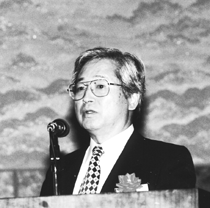
Hidehiko Tanaka
Chairperson of the Committee of Project for Fundamental Information Technology of the Next Generation, Ministry of International Trade and Industry (MITI)

|
Hidehiko TanakaChairperson of the Committee of Project for Fundamental Information Technology of the Next Generation, Ministry of International Trade and Industry (MITI) |
Toward the New Information Society
Hidehiko Tanaka
Chairperson, Promotion Committee University of Tokyo |
Fig. 1
Like "I in Ambiguous Japan" or "Ambiguous I in Japan" ("Aimai na Nihon no Watashi" in Japanese) addressed by Kenzaburo Oe, the meaning of the word "new" in the title of my speech is still ambiguous.
This year is the second year in the second phase of the RWC project (Fig. 2).
Position of R&D of RWCP during This Fiscal Year
|
Fig. 2
Last fiscal year, we narrowed down the researches that were conducted during the 1st phase, and the "refinement" process is now underway. Therefore, in this year the "substance" of research and development during the 2nd phase will be determined. Let's talk about the information society for some time.
There are two main types of technologies which support the information society: A and B (Fig. 3).
Technologies which Support the Information Society- To support individual users - Global, fast-paced society through optical/wireless communications B. Technologies for Ease-of-Use - From machines for experts to tools for everybody C. Technologies for providing equipment to support daily activities of people worldwide - Vast markets |
Fig. 3
First, we should provide as much personal, individual user support as possible. Technologies using very fast optical communications or location-independent wireless communications have advanced quickly, and by combining these we can create an integrated computing world for personal use and networking.
Second, ease of use must be maximized. Computers are used by many people, yet only some 10% of the population uses them in Japan. Although people have learned how to use computers the hard way through familiarity, there is still much room for improvement, particularly reliability. In the future, 80% of the population will use some kind of information processing machine, but machines have not reached this level yet. To enable this to happen, the support of intelligent processing is required, yet there is no de facto worldwide standard for the machines. But the market size will double or triple that of PCs, and we would like to penetrate this vast, emerging market.
The RWCP's approach is two-fold (Fig. 4).
RWCP's Approach
|
Fig. 4
The one approach is "Parallel and Distributed Computing" and the other is "Real World Intelligence". Mapping these onto the work that lies ahead as outlined already, Parallel and Distributed Computing will support personal use and networking, while Real World Intelligence will bring about true ease of use and intelligence through basic research. These are the two core areas of future research.
Now let's look at them more closely. First, personal use and networking (Fig. 5).
[A] Personal Use and Networking
|
Fig. 5
First, let's look at easy personal supercomputing. While many PCs and workstations are currently connected via LANs, the goal is to allow users to derive easily the desired computing power using what they have now. And if such performance can be derived, it should appear as a single system that is easy for users to understand. This is what "seamless" means. The fundamental technologies for this include seamless computing, parallel software, and next-generation high-speed communication and its integration technology among others.
From this perspective, conventional computing environments have many problems as we know from our own day to day experience (Fig. 6).
Conventional Computing Environments
|
Fig. 6
First, there are many differences. It is difficult to use different hardware, OS, languages, and multiple machines concurrently in order to derive the desired computing power. Users typically use only a single machine; multiple machines are not handled as much. Second, processing vast amounts of data may require the use of special machines such as parallel supercomputers, but such machines are usually developed separately, and are not suitable for ad-hoc use by ordinary people. A third problem is the bottleneck caused by communication speed, which prevents us from turning multiple machines into a single one, as well as the problem of differences in optimization. Specifically, when we port a parallel program running on one machine to another, it usually will not run properly. This is the situation at present.
Currently, RWC research is underway to solve such difficulties (Fig. 7). I will not go into the specific themes which will be discussed in due course, but various research is being conducted in this field according to the purposes discussed before. Fig. 8 shows seamless computing, in which Windows, UNIX, and massively parallel machines are connected via a high-speed LAN, and has a flexible image as the user perceives it either as a supercomputer or a small PC. When some software is run on any of them, the user sees only a simple computer that's easy to use but with flexible computing power. Even if all of the OS's on this LAN system are identical, the single image, i.e., the capacity that computing power may be changed freely, is not realized yet. Current systems are still far from this single image, but seamless computing will fill the gap.
Parallel and Distributed Computing
|
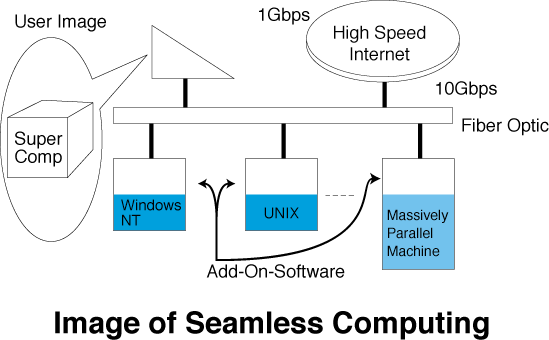
Fig. 8
What can be expected from the research work (Fig. 9)?
Results Expected from Researches on Seamless Computing
|
Fig. 9
Fig. 9 shows an image of potential outcomes from what we have now, which should be progressively developed by those actually involved in the work. First come the single system, i.e., the standard architecture. We should propose an architecture to show what computers are like. By building a converter for it, multiple machines are viewed as a single system. The second is the "Provision of Key Technologies" to realize this single system image, which we should develop and provide. The third is verification of the effects. Once such a single system image, i.e., an environment for seamless computing, has been created, we can then assess what we like and what is actually possible. Together with applications, this is very important. In addition, one of the results may be the software which provides plug-and-play capability of seamless computing when installed in various PCs and workstations currently used in workplaces.
The development of easy-to-use computers, which is the second item under the first topic, is that of intelligence technologies (Fig. 10). There are various forms of information in the world today. Besides multimedia types of information, information that has yet to be sorted out should be self-organized so that computers can use it. And the world will go on changing, as will circumstances. Another required function is autonomous learning which progressively incorporates more information. And there are different types of media, not simply text data but different media should be exploited like humans. At the heart of it will be computers. In addition, computers and information systems should have human-like knowledge. The interfaces will then change drastically, but being human-like in everything is a tough challenge, so for the time being systems should have human-like knowledge in specific areas. These are the core factors in building intelligent tools.
[B] Intelligence Technology
|
Fig. 10
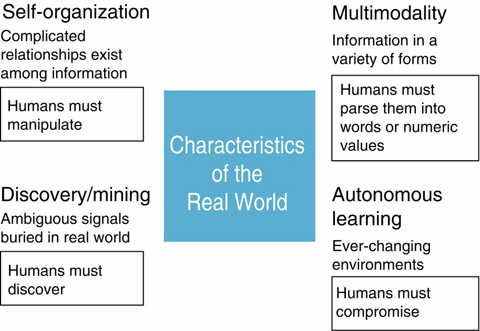
Fig. 11 shows the characteristics of the real world, which includes many different problems, complicated relations among information, ambiguous information buried in the real world, ever-changing environments, and a variety of information forms. Conventionally, humans organize these, discover them, make compromises, or consolidate them numerically. Making computers handle such work is another important research theme.
Easy-to-use Information Equipment
|
Fig. 12
What is easy-to-use equipment (Fig. 12)? Well, it should have knowledge and learning functions, the ability to determine on its own the important parts of information, and it must be multimodal. It also should not be limited by restrictions on location, distance, or OS. Such equipment should form one image. Users still use information equipment at the read, write, and compute level, such as using Word or Excel. But imagine a higher level of computer usage with a search, consult, and design interface, for instance, when making travel plans. Search means to look for places to visit from vast amounts of video sources. Users then consult with the computer about which flight to take and which hotel to stay at. Of course, computers are connected via networks to perform many types of processing, and computers acting as travel agents are consulted. Users base their travel plans on it, including the departure date and charges. Making plans could be called design. In the age of information when both the young and old use computers, this type of interface can be expected.
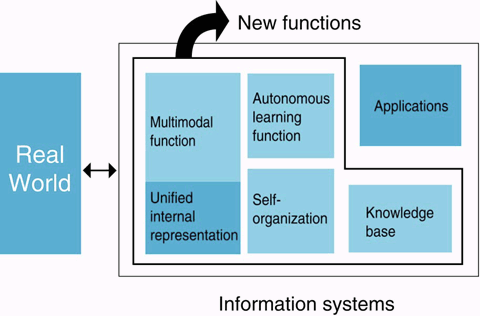
This figure illustrates many modules (Fig. 13) included in information equipment, which is enhanced by adding such new functions to the real world. Information systems may be considered as such equipment.
The RWC Project conducts various research in this field under the following groupings (Fig. 14).
Real World Intelligence Research
|
Fig. 14
The first three have been discussed above, so now let's turn to the last three. Researches on adaptive devices address next-generation device design methods, some of which may be of interest to you. There are also the Theory and Algorithm Bases group to support all the other research activities and the Intellectual Resources for R&D to provide software, tools, and databases to support the entire research. These are all the activities.
What applications are likely to come out of these researches (Fig. 15)?
Applications of Real World Intelligence Research
|
Fig. 15
The members of related groups have many ideas about this, but let's make it simple. First, there are the intelligent robots, which automatically recognize the outside world, gather knowledge on it, and adapt themselves to it. Second, there are the tools that use different media in an integrated manner. The third item is the flexible high-level interfaces for humans that must be designed. Fourth is the creation of intelligent personal secretaries, which are of course electronic, although human ones may be preferred. And finally we have new adaptation device design technologies.
By considering the RWC Project activities in this way, its characteristics can be summarized as follows (Fig. 16). First, seamless computing. "Direct pathway to technologies in the near future" in the figure means that research should be conducted focusing on technologies in the relatively near future. Those researches should also be done not on simply ideas but on technologies for actual use. And since this field experiences drastic changes, we should quickly adapt to changes in direction or quickly employ anything that can be used. Finally, R&D activities should focus on key technologies, rather than on many different things.
[C] Characteristics of RWC Researches (1)
|
Fig. 16
The Real World Intelligence is slightly different, in that research is focused on applications in the more distant future to develop the basis for intelligent technologies (Fig. 17).
Characteristics of RWC Researches (2)
|
Fig. 17
In this field, as shown by the title "True intelligence should come from the real world", researches are focused on the real world. Therefore, they involve creating a corpus and gathering image data and speech data, not simply as tools for research, but gathering itself is an important task. And then by showing specific applications, intelligence technologies will be demonstrated as the final goal.
What are the potential outcomes from these researches (Fig. 18)? Roughly speaking, they will constitute fundamental technologies several years from now, i.e., preliminary researches for that time, including the proposal of models for personal information terminals for everybody or a great impact on models for advanced intelligent robots.
Expected Impacts
|
Fig. 18
Information terminals may be depicted as follows (Fig. 19):
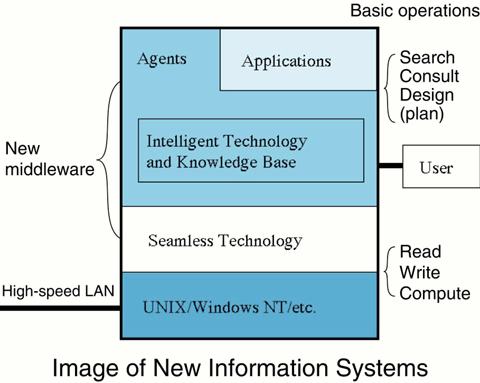
At the bottom lie various de facto OS's. Seamless computing technologies are placed on top of these, upon which many agents are placed, which have well-defined interfaces to communicate with one another and provide users with search, consult, and design interfaces. In addition to the conventional interfaces for read, write, and compute, fundamental intelligent agent technologies and knowledge base technologies are required. The combination of these agents and seamless computing is called new middleware.
Let's look at this middleware more closely (Fig. 20).
Configuration of Middleware
|
Agents include lawyer agents, physician agents, travel agents, and cooking agents. These agents communicate with one another to get many different jobs done. Such a world should be an open world.
Conventional computers usually communicate with one another according to predefined rules called protocols, but the agents at this level should be independent from protocols (Fig. 21).

One example is natural language. Humans use natural language to interact with other humans. Natural languages may be considered as protocols with much more freedom. These agents should have such interfaces. They must also adapt to changes. They should determine what information they need and use it for what they need, as well as structure and store information.
Finally, the next figure summarizes the expectable nature of the RWC Project (Fig. 22).
For advancing researches:
|
Fig. 22
First, we should encourage discussions within each group and among different groups. By attracting researchers, RWCP should become a base for publishing information to the world, and since extensive commercial opportunities require a solid foundation, ideas on basic research should be exchanged, the results quickly published and made available to the world, and feedback utilized, thus forming a virtuous cycle. One example is to test various possibilities. And the results should be quickly returned to society. In fact, some interesting research work is being done in the RWCP, as mentioned in Mr. Okada from MITI speech given earlier. Many researches have already returned the results to society. Such research work should be nurtured and developed. Above all, the basis for the future is information technology.